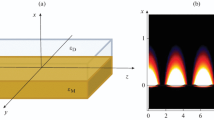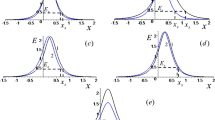Abstract
Surface plasmons (polaritons) along the boundary between vacuum and a dissipative half-space with given complex permittivity, including the case of placing an electrically thin dielectric layer (system of layers) on the boundary, are considered. Conditions for transformation of a fast gliding Zenneck surface wave (polariton) into a slow wave (slow surface plasmon) are considered. The behavior of the group velocity and the energy velocity of motion (transfer) in such structures are analyzed. The reflection coefficient of the Zenneck wave along the sea for the ice pack of a given thickness is determined. It has been shown that rigorous solution of the Sommerfeld problem by means of numerical calculation of integrals in the near zone allows obtaining the solution of the inverse problem of the structure of the surface region on the basis of redundant experimental data on components of the electromagnetic field on the surface at different ranges from the antenna.
Similar content being viewed by others
References
L. A. Vainshtein, Electromagnetic Waves, 2nd ed. (Radio i Svyaz’, Moscow, 1988) [in Russian].
M. V. Davidovich, Gliding and Leakage improper waves—the Analysis of Dissipative Dispersion Equations and the Zenneck Wave (Saratov. Gos. Univ., Saratov, 2014) [in Russian].
S. A. Maier, Plasmonics: Fundamentals and Applications (Springer-Verlag, New York, 2007; RKhD, Moscow–Izhevsk, 2011).
V. V. Shevchenko, J. Radioelektron., No. 7 (2013). https://doi.org/jre.cplire.ru/jre/jul13/7/text.html.
V. V. Shevchenko, J. Commun. Technol. Electron. 60, 335 (2015).
A. V. Kukushkin, A. A. Rukhadze, and K. Z. Rukhadze, Usp. Fiz. Nauk 182, 1205 (2012).
G. T. Markov and A. F. Chaplin, Excitation of Electromagnetic Waves (Radio i Svyaz’, Moscow, 1983) [in Russian].
J. Zenneck, Ann. Physik. Sept. 23, 846 (1907).
D. G. Baranov, A. P. Vinogradov, K. R. Simovskii, I. S. Nefedov, and S. A. Tret’yakov, JETP 114, 568 (2012).
M. V. Davidovich, JETP 123, 928 (2016).
I. S. Nefedov, C. A. Valagiannopoulos, and L. Melnikov, J. Opt. 15, 114003 (2013).
V. V. Shevchenko, Usp. Fiz. Nauk 177, 301 (2007).
V. V. Shevchenko, J. Commun. Techn. Electron. 49, 639 (2004).
V. V. Shevchenko, J. Commun. Techn. Electron. 50, 1260 (2005).
I. V. Shadrivov, A. A. Sukhorukov, and Y. S. Kivshar, Phys. Rev. E 67, 057602 (2003).
N. P. Balabukha, A. A. Basharin, and V. N. Semenenko, J. Commun. Technol. Electron. 54, 898 (2009).
N. P. Balabukha, A. A. Basharin, and V. N. Semenenko, JETP Letters 89, 500 (2009).
A. A. Basharin and N. L. Men’shikh, J. Radioelektron., No. 11 (2010). https://doi.org/jre.cplire.ru/iso/nov10/2/text.html).
V. V. Shevchenko, J. Commun. Techn. Electron. 55, 986 (2010).
V. V. Anenkov and V. V. Shevchenko, J. Commun. Technol. Electron. 56, 1186 (2011).
A. A. Basharin, M. Kafesaki, E. N. Economou, and C. M. Soukoulis, Opt. Express 20, 12752 (2012).
A. A. Basharin and N. L. Menshikh, Appl. Phys. A 106, 517 (2012).
K.-Y. Kim, J. Jung, and J. Kim, arXiv:1007.0396.
V. P. Mal’tsev and A. D. Shatrov, J. Commun. Technol. Electron. 57, 170 (2012).
D. V. Valovik, PIERS ONLINE 7, 721 (2011).
A. P. Anyutin and A. D. Shatrov, J. Commun. Technol. Electron. 58, 417 (2013)
A. D. Shatrov, J. Commun. Technol. Electron. 52, 1324 (2007).
P. Tournois and V. Laude, Opt. Com. 137, 41 (1997).
E. Yu. Al’tshuler, M. V. Davidovich, and Yu. V. Stefyuk, J. Commun. Technol. Electron. 55, 98 (2010).
M. V. Davidovich, Iterative Methods for Solution of Electrodynamic Problems (Saratov. Gos. Univ., Saratov, 2014) [in Russian].
Author information
Authors and Affiliations
Corresponding author
Additional information
Original Russian Text © M.V. Davidovich, 2018, published in Radiotekhnika i Elektronika, 2018, Vol. 63, No. 6, pp. 499–506.
Rights and permissions
About this article
Cite this article
Davidovich, M.V. On the Condition for Transformation of a Fast Surface Wave into a Slow Surface Wave. J. Commun. Technol. Electron. 63, 497–504 (2018). https://doi.org/10.1134/S1064226918060050
Received:
Published:
Issue Date:
DOI: https://doi.org/10.1134/S1064226918060050




